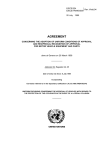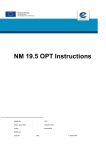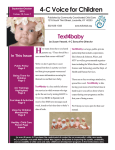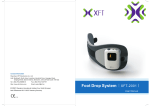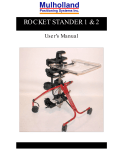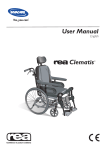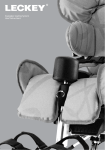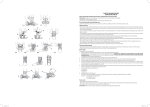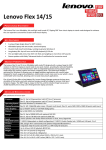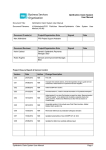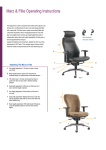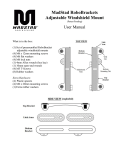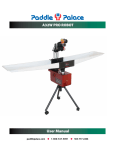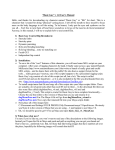Download peer level stander™ adjustments
Transcript
PEER LEVEL STANDERTM PRONE ASSEMBLY User’s Manual 1 TABLE OF CONTENTS 2 Preface 3 Precautions 3 Required Tools 4 Components 4 Assembly 5-9 Trouble Shooting 10 Fitting Instructions 10 Adjustment Overview 11 Adjustments 12-15 Options: Prone Neckrest and/or Shoulder Pads 16-17 Placing the Child in the Stander 18 Maintenance 19 PREFACE: These pages provide information to professionals for the set up and use of the Prone Assembly version of the Peer Level Stander. The Mulholland Standing Systems are designed to provide individuals requiring prone, vertical, or supine standing, precise postural control at the upper trunk, pelvis, knees and ankles. All standers adjust from prone to vertical to offer therapists the opportunity to provide graduated weight-bearing to promote more normal tone distribution and stability, and selective extension of the spine. Standers also stimulate head-righting, weightbearing on the forearms and mid-line hand use. Standing provides an additional opportunity for peer socialization and interaction, and upper extremity activities should be an integral part of the standing program. PRECAUTIONS: Standing should always be prescribed by the child's physician with recommendations for the duration, frequency, and contraindications.The standing program should be closely monitored by the child's therapist. USE OF THE STANDER SHOULD BE UNDER DIRECT ADULT SUPERVISION AT ALL TIMES. 3 REQUIRED TOOLS: • • Tape Measure Allen Wrenches (3/16”, 5/32”) (Included in tool pouch) COMPONENTS: Refer to Figure 1. 1. Knee Blocks 2. Hip Support 3. Column 4. Trunk Support 5. Chest Support 6. 7. 8. 9. Column Pivot Strut Frame Brace Side Frames 5 4 3 6 2 1 7 8 4 Figure 1 9 PRONE ASSEMBLY INSTRUCTIONS: 1. Attach the two side frames to the frame brace. 2 2. With the two side frames attached (they may need to be slightly loose), slide the pivot bar into position. 3. Tighten the TWO bolts on the bottom of each side, and make sure the block is situated so the pivot bar is above the frame. 5 4. Three important measurements to insure the column is properly positioned on the frame are: (fig 5A) 14 3/4” from the top of the pivot clamp to the top of the main column piece; (fig 5B) 4” from bottom of pivot to the top of the gas strut; (fig 6C)15 1/4” on a diagonal from the front of the pivot bar to the back end if the top cross brace. Figure 5 A 14 3/4” B 4” Figure 6 C 15 1/14” 6 5. Attach the upper end of the gas strut to the receiver mounting (fig 7A) on the main column. Then attach the lower (and thinner) end of the black gas strut to the black plate between the cross bars (fig 7B). Tighten these bolts well. Figure 7 A B 6. The tray mounting tubes (fig 8A) should be attached approximately 6” from the front edge of the crossbar mounting block to the center of the tray bar mounting block with the tray mounting tube pointing upwards and mounted on the inside of the side frame (fig 9B). Retighten the screws. B A Figure 8 Figure 9 7 7. Finally add all the hardware. The slings (fig 10A) will simply slide into the sling holding clamps or the intact sling units can be slid on to the main column and secured with push pins. The chest support (B) drops down into the column and is secured with a push pin, if it isn’t already attached to the upper sling. The knee blocks (C) slide into their adjustment clamps on the knee bar, the short cross bar below the pivot bar on the main column. The shoe holders (D) can slide up on to the bottom of the column and secured with a push pin. Lastly, the tray (E) drops into its mounting tubes. B A E C D 8 Figure 10 A Figure 11 8. To adjust the angle of the stander the operator should stand behind the unit and while squeezing the trigger (fig 11A) on the left side of the frame, use their foot to move the column to the desired angle. 9 TROUBLE SHOOTING: Careful alignment of the Peer Level Stander during assembly is critical to the correct functioning of the mechanical tilt mechanism. If the stander doesn’t tilt correctly after assembly check the following list of common problems. The frame is not square: The side frames need to be parallel to each other and the frame braces need to be perpendicular to the side frames. The knee block bar is not parallel to the frame braces. The column is twisted. The push pin holes need to be in line with the column pivot. FITTING INSTRUCTIONS: The following measurements are required prior to fitting the Peer Level Stander: 10 1. Heel to iliac crest: This is the measurement to the top of the hip support. ___ 2. Groin to mid-scapula: This is the measurement to the top of the trunk support. ___ 3. Floor to mid-knee: This is the measurement to the middle of the knee support. ___ 4. Hip width: This is the measurement of the width of the hip support. ___ 5. Trunk width: This is the measurement of the width of the trunk support. ___ 6. Leg length discrepancy: The amount of distance that the individual foot support must be lowered on the longer side. ___ ADJUSTMENT OVERVIEW: The separate and combined adjustments are critical to the effectiveness of the Peer Level Stander. The therapist is encouraged to try various adjustment combinations to find the optimal position for weight-bearing, tonal balance and head-righting. It is further recommended that an on-going adjustment schedule be identified to meet the needs of physical growth, decrease or increase in postural support, and weight bearing activities. • • • • • Column Tilt (Pitch): Affects the child's orientation in space, postural tone and distribution of weight. Hip and Trunk Supports: Provide not only lateral, but also anterior/posterior support. Although the hip support should always be snug, the trunk support can be graded to allow for lateral movement as the child acquires increased trunk control. Knee Supports: Knee blocks provide not only anterior support, but can also change in angle to accommodate flexion at the knees. Foot Supports: The full Footplate was designed for a level weight bearing surface. The 5-Way Adjustable Foot Supports can accommodate anterior/posterior adjustment, leg length discrepancies, plantarflexion/ dorsiflexion, and rotation Tray Height: Tray height adjustment can provide an upper extremity weight-bearing surface (to assist with head control), and a surface for activity placement. A pitch adjustable tray is available for an additional charge. 11 PEER LEVEL STANDER™ ADJUSTMENTS: Note: The columns on these standers telescope up from the foot support. This allows the child to stand as close to the floor (peer level) as possible. NEVER MAKE ANY OF THESE ADJUSTMENTS WITH THE CHILD IN THE STANDER! • • • • 12 Foot Support: Initially, measure from the foot support to the knee pad and lower or raise the foot supports to the desired height (floor to mid-knee measurement) with the push pin (fig 12A). Note: Fine tuning instructions for the Foot Supports to follow. Trunk Support: Removing both push pins (B & C) pull the column up to the correct height for the chest support and put trunk pin (B) in place. Place the chest support (D) to approximately the level of the child's clavicles. Note: This is not a chin rest. Hip Support: Pull the hip support up to the desired height (heel to iliac crest measurement) and replace the pin (C). Hip and Trunk Support Widths: Loosen the black knobs (E) and slide the bars to the appropriate width (you may need to loosen the straps). It is very important to make sure that the outsides of the bars are an equal distance from the mid-line of the column. If they are not, the child may not be weight bearing evenly. Tighten the knobs and re-velcro the inside strap. This will be adjusted later as part of the "fine tuning" while the child is in the stander. Complete this adjustment for both the trunk and hip supports. • Tray support: Adjust the height of the tray by lifting the tray to the desired height, loosening the allen screws on the stops (F), placing the stops at the appropriate height, and retightening the screws. D B C F E A Figure 12 13 • • 14 Adjustable Knee Supports 1) Angle: Loosen the allen screws (fig 13A) and tilt to the appropriate angle to support the knees. Retighten. 2) Width: Loosen screws (A) and slide to the correct width to assist in alignment of the lower extremity. Retighten. 3) Height: Small height adjustments can be made by loosening screws (B) and moving the knee pad on the vertical post. 4) DO NOT ADJUST THE PLACEMENT OF THE COLUMN BRACKET (F) ON THE STANDER! Foot Support Adjustments: 1) Footplate Height: Release the push pin(fig 13C), and adjust the height. 2) Five-Way Foot Supports: a) Height: Release the push pin(C), and adjust the height. b) Leg length discrepancy: Lower foot support to accommodate the lower leg by releasing the push pin (C) and placing it at the appropriate height. Then unscrew the side with the shorter leg and adjust accordingly. c) Abduction: Loosen the screws (D) and adjust the width between the shoe holders. Note: Excessive abduction may cause increased weight-bearing on the medial borders of the feet. d) Plantarflexion/Dorsiflexion: Loosen the screws (D) and adjust. e) Rotation: Loosen the nuts under the shoe holders and pivot. f) Inversion/Eversion: Loosen the allen screws (E) and adjust the angle. Retighten. 3) AFTER ADJUSTING FOOT SUPPORTS, RECHECK TO MAKE SURE THAT ALL OF THE SCREWS HAVE BEEN TIGHTENED. An appropriate fitting is that which supports the child securely and promotes symmetrical weight-bearing. Figure 13 15 PEER LEVEL STANDER OPTIONS: 16 Prone Neckrest and/or Shoulder Pads: 1. Assembly: a) Mark the position of the foot and knee supports and then remove them from the main column. To remove the foot supports, pull out the push pin and slide the support off the column. To remove the knee supports, do the same, as well as loosen the two allen screws securing it in place. b) Slide the mounting support tube (fig. 14A) into place, with the tube sticking out backwards between where the knee blocks go. c) Reattach the knee and foot supports to their original positions. d) Attach the remaining segments to the mounting tube (fig 15). e) Measure the height to the top of the child’s shoulders and then to the mid ear. f) Adjust the height of the shoulder pads to the height of the top of the shoulders, and the middle of the neckrest to the mid-ear height, using the foot supports as the baseline. 2. Fitting: a) Remove the mounting by pulling out the push pin (fig. 14C). b) Place the child into the stander (follow the instructions). c) Release the shoulder pad pivots by pulling the ring back to release and swing open (pointing away from the column.) d) With the child in the stander, slide the mounting column (fig. 14B) onto the horizontal tube (fig. 14A) close to the child and reinsert the push pin. e) Adjust the depth of the neckrest by releasing the two allen screws that attach it to the vertical mounting bar. f) Adjust the depth of the shoulder pads: 1) Loosen the front retainer ring (fig. 14D) to allow adjustment. 2) Loosen the rear index clamp (fig. 14E) and move the shoulder pads in place to provide the appropriate amount of anterior support. 3) Tighten the index clamp (fig. 14E), making sure that it is aligned so that the shoulder pad will lock in two positions: set and out-of-theway. E 4) Tighten the inner retainer ring (fig. 14D) to provide enough tension to allow the pivot to lock into place. D B C A Figure 14 Figure 15 17 PLACING THE CHILD IN THE STANDER: 1. Always lock all four casters before putting the child in the stander. This is done by stepping on the lock lever on each castor. 2. The child's therapist should identify whether or not one or two people should be required for the standing transfer. 3. Placing the child's feet on the foot supports, slowly lift him/her into the stander, fastening the hip straps first, then the trunk straps. After checking for proper alignment and weight bearing, fasten the buckle straps on the hip and trunk supports, the foot supports, and the knee straps. 4. The child should be directly supervised at all times. 5. Provide a table or socialization activity while the child is standing. 6. Observe the child closely for signs of fatigue, distress, or discomfort, and remove the child within the prescribed period. 18 MAINTENANCE: 1. Keep the stander clean. The metal and plastic parts can be washed with a mild concentration of dish soap (the same as is used on your dishes). Rinse with water and dry. Wipe down all of the upholstered parts with a damp cloth. 2. Check weekly for frayed straps and Velcro. For the child's safety, discontinue use of the stander until worn Velcro and straps are replaced. 3. Periodically check for loose screws and tighten them as needed. 19



















